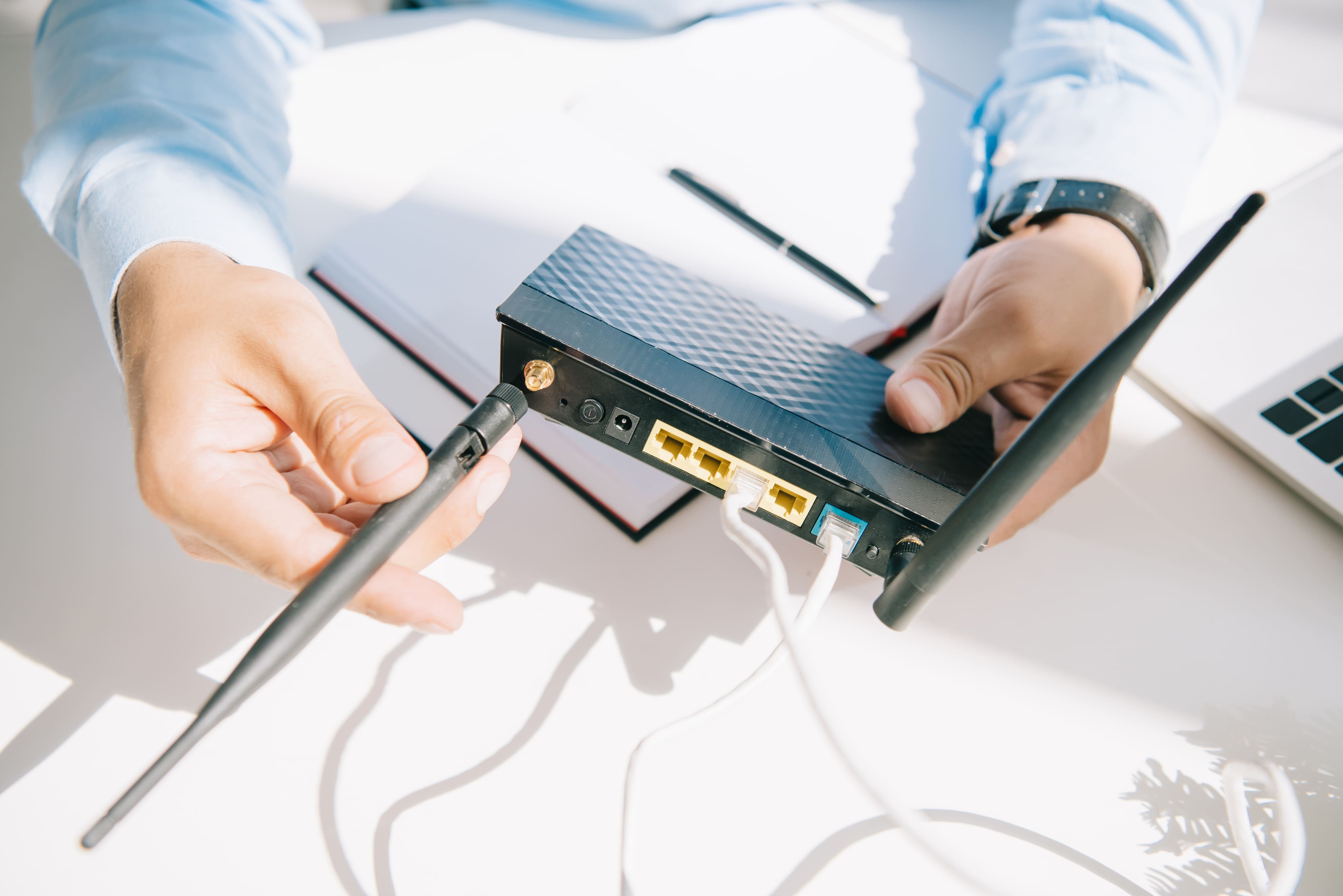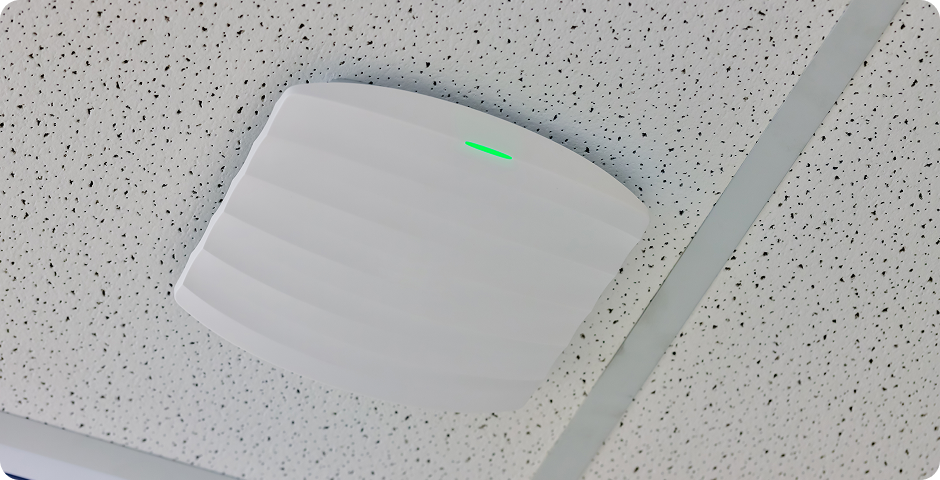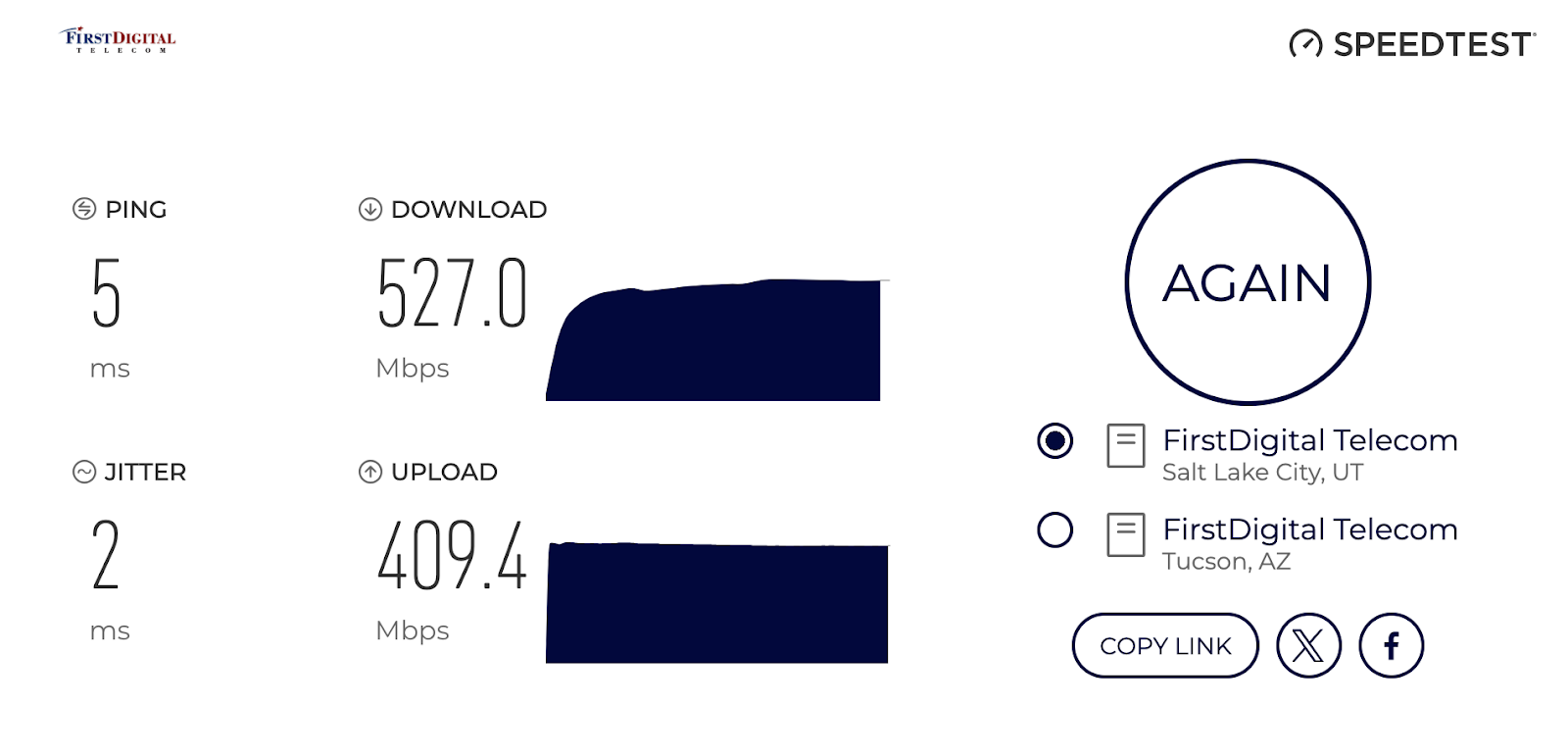
Dedicated vs Shared Fiber Networks: What Business Owners Need to Know
American businesses are increasingly dependent on reliable, high-speed internet. From e-commerce to video conferencing to cloud-based software, virtually all of our work is connected to the internet somehow.
Andrew Bruley-Moore
Network Engineer
Business Internet
If you’re exploring business internet options, you’re likely aware of the massive benefits of fiber for business owners, but do you need your own fiber network or can you share with a neighbor?
In this article, we’ll explore the key differences between dedicated and shared fiber, and help you decide which option delivers the speed, security, and reliability your business needs to thrive.
What is Fiber internet?
Fiber internet is a type of service that uses fiber-optic cables made of small, flexible glass strands to transmit data via light. This technology enables better speed, reliability, and security than traditional cable internet. Light signals can travel faster and more reliably over long distances and carry more data than traditional copper internet cables.
What is a Dedicated Fiber Network?
A dedicated fiber network, also referred to as “Direct Internet Access” (DIA), provides a private, secure connection for businesses who need high bandwidth, and increased speeds and security from their network provider. If you often send or receive large files from clients, use video conferencing software, or accept online transactions, a dedicated business-grade fiber network will likely improve your business’s speed and efficiency so you can reach your growth goals faster.
What is a Shared Fiber Network?
A shared fiber network, as the name suggests, is a single strand of optical fiber used to provide internet access to multiple destinations or customers. Shared networks are also referred to as “Passive Optical Networks” (PON). Unlike a dedicated fiber network, PONs use a single fiber strand to serve up to 32 customers.
The biggest variable with a shared fiber network is speed. Shared networks offer asynchronous connections, meaning that your upload and download speeds will be different and your browsing speeds may be throttled during peak hours.
Shared fiber networks are more affordable than dedicated fiber networks, making them one of the best internet options for small businesses, startups, and residential customers who don’t need consistently high speeds to be successful.
Dedicated vs Shared Fiber: Key Differences
Both dedicated and shared fiber networks have their benefits and drawbacks, and you’re probably wondering which option is best for your business. Here are some of the key differences between private and shared fiber networks to help you decide:
- Speed and Bandwidth: In contrast to a shared network, dedicated fiber offers guaranteed synchronous bandwidth 24/7. During peak usage hours, shared subscribers will have significantly less bandwidth available since they are sharing a single cable with other users. Dedicated networks do not get clogged with other users, meaning you get access to fast, reliable internet access whenever you need it.
- Reliability: Fiber internet, whether dedicated or shared, is generally incredibly reliable. However, due to variable speeds during peak hours, shared fiber users may experience lower reliability in exchange for cheaper internet access.
- Security: Private fiber networks offer enhanced security measures, including firewalls and encryption protocols, making it a better choice for businesses who handle sensitive data like health information or credit card numbers. Shared networks increase the risk of unauthorized access or data breaches if proper
security measures aren’t in place for each user on the network. - Scalability: Dedicated fiber networks can be easily scaled up or down depending on your business’ needs or usage. This is very useful for companies who expect to grow quickly and need all employees to have access to consistent internet speeds, reliability, and security. Shared Fiber networks are limited to their scalability due to the resources of this connection being shared with other users.
- Cost Considerations: Because of the increased speeds, reliability, and security customers get with a dedicated fiber network, installation and service costs will be higher than those of a shared network. However, as technology advances quickly, fiber access is becoming more and more common, which will reduce prices in the long run.
Is Dedicated or Shared Fiber Right for Your Business?
Dedicated fiber networks have a lot of appealing benefits, including consistently high speeds, reliability, and constant availability. While shared networks are more affordable, private fiber networks are the superior choice for businesses who need to conduct video conferencing, upload files to the cloud, or use a lot of data each day.
Customers that may benefit from a dedicated fiber network include:
- Remote teams that use cloud-based software and storage
- High-security industries like finance, healthcare, and technology
- Fast-growing companies that need the ability to scale quickly
Customers who may be a good fit for a shared fiber network include:
- Small offices with basic internet needs
- Budget-conscious startups who are just starting out
- Residential users who don’t need consistent upload and download speeds
Consider FirstDigital for Your Fiber Internet Needs
In today’s digital-first world, the type of internet connection your business relies on can directly impact productivity, customer experience, and your bottom line. While shared fiber may be a suitable starting point for smaller teams or budget-conscious startups, dedicated fiber is the gold standard for businesses that require consistent speed, security, and scalability. It’s a strategic investment in your infrastructure—one that can support everything from seamless video conferencing to fast, secure data transfers as your business grows.
If your business depends on always-on connectivity and high performance, now is the time to explore how a dedicated fiber solution can support your goals. Learn more about how FirstDigital can provide the speed, security, and service your business deserves. Don’t let your internet hold you back—upgrade to a solution built for growth.

Dedicated vs Shared Fiber Networks: What Business Owners Need to Know
American businesses are increasingly dependent on reliable, high-speed internet. From e-commerce to video conferencing to cloud-based software, virtually all of our work is connected to the internet somehow.
Andrew Bruley-Moore
Network Engineer
Business Internet
In today’s always-connected world, fast and reliable internet isn’t just a luxury, it’s a necessity. For business owners especially, it's essential to staying competitive in a $6.8 trillion e-commerce market.
With many service options, speeds, and technical terms, choosing the right internet plan for your home or business can feel overwhelming. Understanding the differences between traditional cable internet and fiber internet is the first step toward making a smart, future-ready choice for your business and your customers.
In this article, we’ll explore what the differences are between different types of internet, what you can expect from each, and tips for selecting the best internet option for you.
What Is Traditional Cable Internet?
Cable and fiber are two of the most common types of broadband internet. They both offer wireless access, but how they transmit and receive information differs. Traditional cable internet uses coaxial cables (like those used for cable television) to transmit data via electrical signals. Inside the coax cable is a copper core coated with aluminum, a copper shield, and a plastic coating.
Traditional internet cables are usually buried to avoid damage to the cables, but the cables can be accidentally cut, and are more susceptible to extreme temperatures than fiber-optic cables are.
You can expect decent browsing speeds from traditional cable internet. Often, you will see download speeds between 100-1000 Mbps with upload speeds significantly slower than download speeds. One of the biggest drawbacks of traditional cable internet is that you share your bandwidth with your neighbors, meaning the network runs slower if more people are trying to connect.
What Is Fiber Internet?
Fiber internet uses fiber-optic cables made of small, flexible glass strands. Data travels through these cables as light, which enables much faster speeds and efficiency. Light travels faster and more reliably over distances, and carries more data than traditional copper internet cables.
One of the key benefits of fiber-optic internet over cable internet is faster speeds. Fiber can net speeds from 250 Mbps up to 1 Gbps or more, for both uploads and downloads, depending on your plan. For example, it would take you less than 10 seconds to download a two-hour movie with a fiber internet connection, compared to 20 minutes with traditional cable internet download speeds.
Key Differences Between Broadband and Fiber
Fiber internet generally offers higher security, faster upload and download speeds, and better reliability than traditional cable internet or DSL. Since fiber isn’t as sensitive to temperatures, weather, and electromagnetic interference as cable, you get more consistent, reliable service.
Leading fiber internet providers (like FirstDigital) provide symmetrical speeds, which means download and upload speeds are similar, which is useful for businesses who need to send and receive large files from clients. Symmetrical speeds also make for crisper video calls, efficient remote work, and lag-free streaming.
Which Internet Option Is Best for Your Business?
Fiber internet is becoming more popular, and fiber networks are expanding all the time. FirstDigital, for example, now owns and operates the largest privately owned fiber network in the Intermountain West, with over 2,000 fiber miles. However, availability remains the biggest challenge for many prospective fiber users.
The Federal Communications Commission (FCC) estimates that 95% of the United States can access cable internet coverage at speeds of 100 Mbps download and 20 Mbps upload (100/20) or more. Recent studies with the Fiber Broadband Association have shown that just over fifty percent (56.5%) of the United States has access to fiber internet at 1000 Mbps or more. That means if you live in a rural area, you’re likely to have more cable internet options than fiber.
If you live in an area where fiber is available, and you rely on fast, secure internet access to do the bulk of your business, fiber is likely the superior choice for you. If you live in an area where fiber options are limited, or you don’t need ultrafast upload and download speeds to do your work, a higher tier of cable internet service may suit your needs just fine.
Future-Proof Your Business with Fiber
Even if you think you don’t need the speed and reliability benefits of fiber at this time, fiber is a great choice for future-proofing your business. Every year, American society becomes more and more reliant on high-speed internet and streaming, and businesses will need to adapt to keep up. Even the slightest drop in speeds and reliability can cause you to lose business, so choosing the right connection is critical for your future success and market share.
Ready to upgrade your business internet for unparalleled speeds and 99.999% uptime? Let FirstDigital design your custom fiber network so you can reach your biggest business goals faster.

What’s the Difference Between Fiber and Traditional Cable Internet?
In today’s always-connected world, fast and reliable internet isn’t just a luxury, it’s a necessity. For business owners especially, it's essential to staying competitive in a $6.8 trillion e-commerce market.
Andrew Bruley-Moore
Network Engineer
Network Engineering
Business Internet
Twenty years ago, a wireless internet connection (now more commonly known as WiFi), was a new and exciting concept. Today, it’s embedded into nearly every facet of modern life. Americans spend an average of seven hours a day online. Nearly every home, business, and office building in the United States is connected to a WiFi network, and the technology we use to connect continues to evolve every year.
In 2025, the internet is our connection to everything from scheduling appointments to mobile banking to food delivery. But what exactly is WiFi and how does it keep us connected across timezones and oceans? In this article, we’ll explore the history of wireless internet connectivity, how the technology functions, and how you can optimize your wireless network for optimal speed and security.
What Is WiFi?

The term “Wi-Fi” refers to the wireless technology we use to connect our phones, computers, tablets, and other devices to the internet. Your router sends a radio signal to your device, which then translates the signal into information you can see and hear. This process also works in reverse – your phone or computer sends a radio signal to the router, which then translates that signal into data.
Many people erroneously believe that the term Wi-Fi is short for "wireless fidelity." However, “Wi-Fi” is actually a trademarked phrase that refers to IEEE 802.11x Local Area Network (LAN) standards, which enables devices to communicate over radio waves. The IEEE (Institute of Electrical and Electronics Engineers) sets standards for many technological protocols, and it uses a numbering system to classify these standards.
How Does WiFi Work?
The technology used in WiFi communication is very similar to the radios used for walkie-talkies, cell phones and other devices. Essentially, your WiFi router uses radio waves to send and receive information from other devices. They change digital data (the 1s and 0s) into radio signals and then turn those signals back into data.
Remember to be cautious about connecting to unsecured Wi-Fi networks in public locations, such as cafes and airports. Public, unsecured networks pose a significant risk to device and personal data security due to the use of open communication channels. FirstDigital always recommends opting for password-protected wireless networks or personal hotspots whenever possible.
What are Wireless Access Points?

WiFi routers are also sometimes referred to as “wireless access points (WAP).” These access points act as a hub to other devices, like your phone or laptop, so they can connect to a local area network and access the internet. The router is plugged into an ethernet cable which is connected to the network, making wireless connection possible.
Most Wi-Fi routers can be easily managed through mobile apps or web-based interfaces, making it easy to customize your network settings.
Common WiFi Terms
There are many acronyms and abbreviations to keep in mind when discussing Wi-Fi technology. Here are a few of the most common:
- SSID - SSID stands for “Service Set Identifier.” The SSID is the name of your Wi-Fi network. Wi-Fi routers and access points broadcast their SSIDs so devices can identify and automatically connect to Wi-Fi. When you're looking for Wi-Fi networks on your computer or mobile device, the SSIDs are the names that will appear in the list of available networks.
- Bandwidth - Bandwidth is your Wi-Fi network’s carrying capacity. It refers to the maximum amount of data that can be transferred through an access point in a specific amount of time.
- Latency - Latency, also referred to as “ping,” measures the time it takes for data to travel from your device to a server and back. Lower latency means you get faster, more responsive internet connection, while higher latency can cause laggy connections, buffering, and slow loading times.
- Signal Strength - This term refers to the strength of the signal received by your device from the access point. A stronger signal usually means a faster, more reliable connection. Signal strength is measured in negative dBm (decibel milliwatts). For example, a signal strength of -50 dBm or better is considered excellent, while -70 dBm or worse indicates a weaker signal.
- Encryption - Encryption is the process of scrambling data that is sent over a wireless network to prevent unauthorized access. This makes your data unreadable to anyone without the decryption key, which keeps your personal information – and your customers’ information – safe and secure.
- LAN - A Local Area Network (LAN) is a network that connects multiple end-user devices, like computers, smartphones, and printers, within a limited geographic area like a home, office, or school. A typical example is a home WiFi network, which uses a wireless access point (WAP) to link devices to one another and to the internet, if they remain within the network’s signal range.
How to Optimize Your WiFi Performance
To get the best Wi-Fi reach and ensure you get consistent speeds and performance, we recommend placing access points (APs) in central spots like hallways or main living areas. This way, the signal is strong enough to go through walls and into nearby classrooms, dorm rooms, and offices. Mounting your router reduces the need for extra directional antennas, which keeps your home or office network simpler and more affordable to set up.
It’s also a good idea to be aware of your internet provider’s advertised speeds before you begin troubleshooting any issues. Log into your Wi-Fi provider’s app or website to check how fast your network should be running, and then use FirstDigital’s speed test to check your current connection.
If you’re still having speed issues, consider switching Wi-Fi bands. Most routes have at least two radios: 2.4 GHz and 5 GHz. Some newer systems may also have a third radio accessing even faster speeds. Most modern routers and mesh setups automatically manage your connections with a single Wi-Fi name, which is called band steering. If your internet is slow, it's likely your device is connected to the 2.4 GHz band.
Explore Fiber Internet for Faster, More Reliable Connections
If you're looking for a faster, more reliable wireless connection, the quality of your internet service matters just as much as your WiFi setup. That’s where fiber internet comes in.
Fiber offers unmatched speed, low latency, and the ability to handle multiple connected devices with ease. If seamless streaming, smooth video calls, and lightning-fast downloads are your priority, it may be time to upgrade. Learn more about FirstDigital’s fiber internet options and see how you can take your WiFi performance to the next level.

How Does Wifi Work?
Twenty years ago, a wireless internet connection (now more commonly known as WiFi), was a new and exciting concept. Today, it’s embedded into nearly every facet of modern life. Americans spend an average of seven hours a day online. Nearly every home, business, and office building in the United States is connected to a WiFi network, and the technology we use to connect continues to evolve every year.
Andrew Bruley-Moore
Network Engineer
Network Engineering
Businesses of all types rely on fast, consistent internet connections to everything from making video calls and onboarding customers to running large marketing campaigns. And because so much of modern business relies on having a solid internet connection, you may be wondering if your business has the speed and bandwidth you need to keep up with the demands of your industry.
How are you supposed to know how much is enough? Each business has unique speeds and bandwidth requirements, but in this article, we’ll explore how internet speeds are measured, what can impact your speeds, how to test your current speeds, and what to know before you upgrade your business internet.
How are Internet Speeds Measured?
Internet speed is generally measured in megabits per second (Mbps), which measures the amount of data that can be transmitted over an internet connection per second. The higher the Mbps, the faster the internet speed. Typically, traditional broadband internet offers download speeds of 100-1000 Mbps, while fiber can deliver symmetrical speeds of 1 Gigabit per second (Gbps) or more depending on your plan with your Internet Service Provider (ISP).
For example:
- 1 Kbps (kilobits per second) = 1,000 bits per second.
- 1 Mbps (megabits per second) = 1 million bits per second.
- 1 Gbps (gigabits per second) = 1 billion bits per second.
Bytes vs Bits
An important distinction when discussing internet speeds is the difference between bytes and bits. Web browser speeds are measured in bytes per second. One byte is equal to eight bits.
How are Upload and Download Speeds Measured?
Upload and download speeds are also measured in bits per second. Fiber internet generally offers much faster upload and download speeds than traditional cable or DSL. FirstDigital fiber customers enjoy synchronous speeds, meaning the upload and download speeds are the same.
While fiber generally offers better upload and download speeds than other internet options, actual speeds can vary depending on your specific plan, and whether or not you have a dedicated or a shared fiber network. Dedicated networks have a single user, meaning you’ll have better security, bandwidth, and consistent speeds. Shared networks use a single strand of fiber for up to 32 customers, and speeds can vary based on the time of day and how many users are trying to connect.
To learn more about Dedicated vs Shared Fiber networks, click here.
How Do I Test My Current Internet Speed?
The first step in determining whether your business has enough bandwidth is to check your current speed to be sure you’re getting what you’re paying for.
First, choose a reliable speed test tool, like FirstDigital’s Internet Speed Test. Next, open the speed test website or app, start the test, and wait for your upload and download speeds to appear.

Upload speeds are how long it takes for data, like photos, videos or files, to be sent from your computer to another device. Download speeds are how long it takes for your device to receive information from another device.
Shared networks have variable upload and download speeds, while dedicated fiber networks generally offer synchronous speeds.
What’s the Best Internet Speed for My Business?
Whether you sell flowers or software, in 2025, every business is an online business. Regardless of your industry or product, you need a consistent internet connection and determining how much speed and bandwidth you need is a critical piece of information to have when shopping for business internet.
Before you can device how fast your internet needs to be, there are a few key pieces of information you need, including:
- The type of business you run
- How much data you need to store
- Whether you handle sensitive data regularly
- The number of customers you have regular communication with
- The number of employees who need internet access each day
Because so many businesses are reliant on an internet connection for some part of their business, the Federal Communications Commission (FCC) recommends businesses have at least 100 Mbps in download speeds and 20 Mbps in upload speeds.
For small businesses, startups, and residential users who are doing basic tasks like checking email and browsing the internet, 100 Mbps may suffice. But if your business uses cloud-based software, sends and receives large amounts of data from customers, or plans to scale quickly, opting for a private fiber network with speeds up to 1 Gbps is a good choice.
Why Choose FirstDigital For Fast, Reliable Business Fiber Internet?
Determining the right internet speed and bandwidth for your business isn’t just about staying connected, it’s about staying competitive in an ever-changing digital world. From daily employee communication and file sharing to cloud-based storage and video conferencing, your internet connection is the backbone of your business’s productivity.
Taking the time to assess your current speeds, evaluate your usage, and understand your growth goals can help you make the right decision about when to upgrade and which provider to trust with your business’ growth goals. If you're ready for faster, more reliable business internet, it’s time to switch to fiber.
FirstDigital’s Business Fiber Internet offers high-speed, dedicated connections with symmetrical upload and download speeds, perfect for businesses that rely on consistency and performance. Whether you're a growing startup or a large enterprise, FirstDigital provides scalable network solutions designed to meet your unique bandwidth needs—so you can focus on what really matters: running your business.

How to Determine What Internet Speed Your Business Needs
Businesses of all types rely on fast, consistent internet connections to everything from making video calls and onboarding customers to running large marketing campaigns. And because so much of modern business relies on having a solid internet connection, you may be wondering if your business has the speed and bandwidth you need to keep up with the demands of your industry.
Andrew Bruley-Moore
Network Engineer
Business Internet
No Results Found
Please try a different keyword




